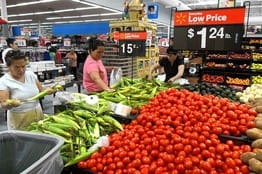The Wall Street Journal (link no longer available)
By Miguel Bustillo and David Kesmodel
Wal-Mart Stores Inc., which scours the globe seeking the lowest-cost suppliers, is finding it can save money by buying more fruits and vegetables grown closer to its stores.
Other food retailers, including Supervalu Inc. and Safeway Inc., also are racing to expand the amount of locally grown food they offer, as more Americans flock to farmers markets and gourmet grocers such as Whole Foods Market Inc. in search of fresher produce.
While some retailers, such as Wal-Mart and Kroger Co., say that buying locally yields savings, most of the chains say their main objective is to satisfy changing consumer preferences.
The lack of a federal standard or any consensus on what qualifies as “local” food leaves grocers a lot of leeway in their marketing. At most large retailers, fruits and vegetables harvested hundreds of miles away can be touted as locally grown.
Such loose definitions have sparked criticism from small farmers and organic-food advocates that the chains are merely adjusting their marketing to capitalize on the latest food trend, rather than making real changes in their procurement practices.
Wal-Mart, the largest grocer in the U.S., with more than $120 billion a year in food sales, encourages its managers to buy produce grown within 450 miles of its distribution centers, even if local peaches, for example, cost more than those produced across the country in California.
That’s because the Bentonville, Ark., giant has determined that, in an era of high diesel prices, trimming the number of “food miles” produce travels cuts fuel costs. Buying locally also reduces produce spoilage, Wal-Mart says, though it won’t quantify the savings.
This summer, Wal-Mart has lined up farmers to grow jalapeño peppers in 30 states, twice as many as last summer. A decade ago, almost all of the chain’s hot peppers came from Florida, California and Mexico.
“We can get chili peppers from Florida all day long, but at the end of the day that is not necessarily the best model for us,” says Darrin Robbins, Wal-Mart’s senior manager for produce. “I’m going to pay a higher price in Ohio for peppers, but if I don’t have to ship them halfway across the country to a store, it’s a better deal.”
The shift–and a related pledge Wal-Mart made last fall to double purchases of locally grown fruits and vegetables to 9% of its U.S. total for produce by 2015—promises to create winners and losers in American farming, with growers in some regions gaining new business and others seeing reduced orders.
To reduce freight and fuel costs, Kroger is buying more lettuce, broccoli and tomatoes in Texas to send to stores in that region, rather than obtaining those crops from California or Colorado. “We use less energy and fuel to store, transport and refrigerate the products,” says a spokesman for the Cincinnati-based retailer, which operates about 2,400 grocery stores and is No. 2 by sales after Wal-Mart.
Supervalu, which owns the Jewel-Osco, Albertsons and Lucky supermarket chains, estimates it now buys between 25% and 40% of its produce locally for its more than 1,100 stores across the country.
Safeway says it has been increasing its local offerings for five years, mostly to satisfy customers. The program “isn’t really a savings vehicle,” says a spokeswoman for the chain, which is based in Pleasanton, Calif.
Agricultural experts say that pests and climate limit what can be grown locally. They say that modern expectations for year-around supplies of blueberries and lemons will keep local food from becoming much more than a fad for most mass merchants.
“I really don’t think Wal-Mart is going to tell customers, ‘This is not in season, you have to eat cabbage and turnips for the next three months,’ ” says Daniel Sumner, an agricultural economics professor at the University of California Davis.
But Wal-Mart’s drive to buy local is proving popular with some farmers. “They drive a hard bargain in Bentonville, but I know what I am getting paid before I put something in the ground, and for a farmer that is huge,” says Sharon Heer of Fewel Farms, in Yakima, Wash., which is growing jalapeños for the chain, and has previously grown pumpkins for it.

Wal-Mart says it spotlights fruits and vegetables as locally grown only if they come from the state in which it sells them. A spokesman says the company made that decision because it is the kind of “common sense” definition consumers expect.
In practice, that means that in large states, such as Texas, sweet potatoes from the Rio Grande Valley can end up being marketed as locally grown in Amarillo, a 12-hour drive away.
Some critics say Wal-Mart is often just relabeling items it would have bought anyway—designating Idaho potatoes as “local” in Boise, for instance.
“So far,I would call it farming by press release,” says Mark Kastel of the Cornucopia Institute, an advocacy group for organic farmers. “They understand the cachet of the good-foods movement.”
Wal-Mart spokesman says the retailer believes that saving money and improving the freshness of foods are not mutually exclusive ideas, adding that its is committed to doing more than just buying local to save money.
What ‘Local’ Means
Various food retailers have their own definitions.
* Safeway Inc. doesn’t consider produce locally grown if it takes more than an eight-hour drive to reach a store. And the company says it normally buys the food “from the closest growing partners first.”
* Kroger Co. loosely defines locally grown, saying the term can refer to produce grown in the same state or within the same region of the country.
* Supervalu Inc.’s definition varies depending on the store banner. Some produce marketed as locally harvested may come from neighboring states.

